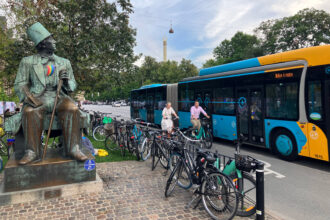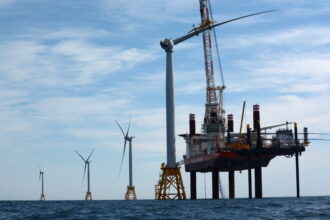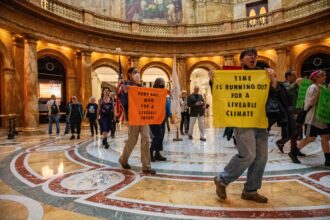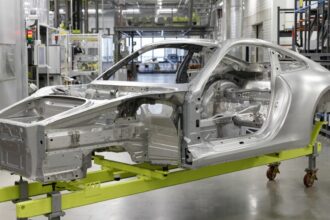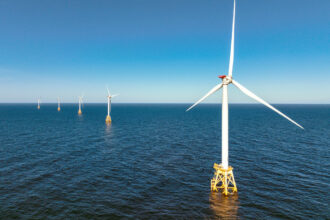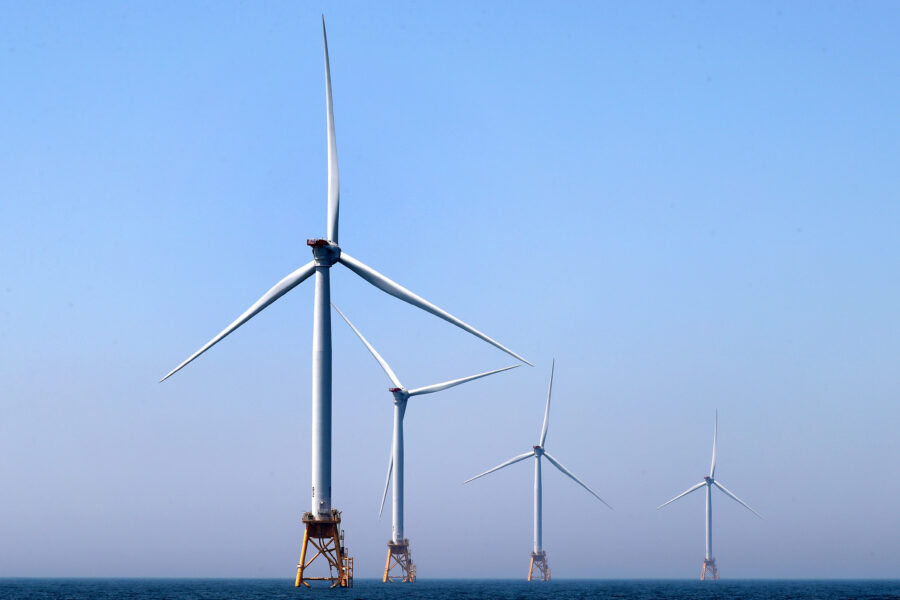People in Denmark have got it good.
With walkable and bikeable cities, awe-inspiring natural beauty and pastries that you want to eat all day long, the country feels almost like a fantasy world.
I traveled there in August to get an up-close look at implementation of ambitious climate policies. The result was a story published earlier this week, about a country where people mostly agree on big things, like the need for aggressive action to reduce emissions, but often disagree about how to do it, and how quickly.
Here are some of the observations that didn’t make it into my story:
Walking through Ørsted’s Maze
I visited the main offices of Ørsted, which are located on the outskirts of Copenhagen, to learn more about the global wind energy company.
Ørsted is one of Denmark’s most successful exporters, with offshore and onshore wind farms in Europe, the United States and Taiwan. It has evolved from a partially state-owned oil and gas company with the unfortunate name DONG, for Dansk Olie og Naturgas, or Danish Oil and Natural Gas.
Ørsted’s complex showed the warmth of Danish design, with wood tones and natural light.
One thing that caught my eye was a display in an atrium that looked like a labyrinth, with blue walls and an open ceiling, and white text written on the walls.
“Discover the path to progress this way,” the text near the entrance read.
An Ørsted spokesman led me through the display, which took about a minute. The text described some of the steps in building a clean energy economy, such as how governments will set up systems to subsidize specific amounts of power capacity.
The piece itself contains shortcuts and doors that allow you to move more quickly toward the end, a conceit that emphasizes the stakes of the company’s work. For example, there is a point where you can turn left to remain on the path of a tightly controlled government process, or you can open a swinging door with the text, “Push to enable industry-led green energy buildout.”

Ørsted isn’t arguing for governments to remove themselves from the process, but it is making a case for governments to be flexible and move quickly, so that projects don’t get bogged down in bureaucracy.
I thought of this labyrinth a few months later, when Ørsted canceled plans for two offshore wind projects in New Jersey because of rising costs. The projects suffered from long delays in the U.S. government’s approval process, and while waiting, the costs soared due to inflation and rising interest rates.
I don’t think the display was specifically referring to U.S. issues, since these kinds of delays happen in many places. But the point was clear, that the clean energy transition can move forward more efficiently when the key players don’t get stuck in a maze.
Rise of the Electric Taxis
Every time I called a taxi or a rideshare service during my stay, the vehicle that showed up was electric. I wondered if there was a government mandate, but I later realized that it was indicative of the country’s broader shift to EVs.
As a practical matter, this meant I got to test drive, or at least “test passenger” some EVs that aren’t available in the United States, like the Volkswagen ID.5 crossover, which is roomy and has smooth handling.
People who work on climate change and energy policy told me that they regard the country’s shift to EVs as a success, but with reservations. Denmark was slow to embrace EVs prior to a leap in market share in 2021.
This is different from other aspects of addressing climate change where Denmark was years ahead of most of its peers.
Also, Denmark suffers from comparison with its neighbor Norway, which is beating everyone in its transition to EVs. Plug-in vehicles were 91 percent of the new cars and light trucks sold in Norway in October. That was roughly double the 44 percent share in Denmark.
For perspective, the U.S. share was less than 10 percent in the most recent quarter.
People in Denmark who buy EVs can get a substantial discount on vehicle registration fees, and there are other policies that nudge people toward EVs. The discounts are often significant.
But government policies don’t completely explain the speed of Denmark’s transition to EVs.
Walking on the sidewalks and riding in vehicles, I could see that EVs were everywhere, and cars with gasoline engines stood out for their noise. A person living here is going to see EVs as a normal and desirable option, as opposed to viewing gasoline as the default.
What Sacrifices Need to Be Made?
Denmark is a small, wealthy country, ranking among the global top 10 in per-capita income. (Denmark ranks ninth and the United States is seventh.)
High incomes allow for high levels of consumption. Some Danes argue that any serious effort to reduce emissions needs to include some cuts in consumption. That might mean households having fewer cars, flying less and eating less meat.
“I would love for everyone in the world to live like a Dane,” said Tiem van der Deure, a Ph.D. student at the University of Copenhagen and an activist with Extinction Rebellion and Scientist Rebellion. “But it’s just not possible. There’s not enough stuff out there.”

We met at Cafe Mellemrummet, a coffee shop in Copenhagen.
His critique of Danish consumption runs contrary to some of the fundamentals of how people in the country have agreed to work together to cut emissions.
Much of Denmark’s success on climate has come from a close relationship between the business community and the government. If the government begins to ask people to spend less and consume less, many businesses would see this as contrary to their interests.
My sense from interviews is that the idea of reducing consumption is gaining support, and some people in the political and business establishment can see this and worry it will lead to much greater discord.
As an outsider to Denmark, I can see how criticism of consumption hits some people in a vulnerable place. Consumption is part of Danish culture, with its delicious pork roasts, pints of Tuborg beer and an abundance of delicious pastries—and that’s just the food and drink.
So van der Deure and others in his movement have their work cut out for them in getting people to support the idea of consuming less.
“The challenge is up to us to make the impossible seem possible, right?” he said.
Other stories about the energy transition to take note of this week:
The Numbers Don’t Support Persistent Fears of EV Conflagrations: Despite fears the lithium-ion batteries in EV are a serious fire hazard, EVs are much less likely to have fires than vehicles with internal combustion engines, as Willie Jones reports for IEEE Spectrum. EVs were involved in about 25 fires per 100,000 sold, while vehicles with internal combustion engines had about 1,530 fires per 100,000 sold, according to a 2023 study from the National Transportation Safety Board. Paul A. Kohl, a professor at Georgia Tech’s School of Chemical and Biomolecular Engineering, said the EV fires get a disproportionate amount of attention because these vehicles are new and different, while people already understand that gasoline vehicles can catch fire, so it’s a “non-event.”
New York City Removes Zoning Restrictions for Rooftop Solar, Energy Storage and Electrification Equipment: The New York City Council has approved the “City of Yes for Carbon Neutrality” plan, which includes zoning changes to make it easier to install rooftop solar and other clean energy technologies, as Joe Burns reports for Utility Dive. This is the first of several proposals from Mayor Eric Adams that are geared toward reducing the city’s emissions 80 percent compared to 2005 levels by 2050. The new rules have fewer restrictions on rooftop solar and solar parking canopies, along with energy storage and electrification equipment.
This story is funded by readers like you.
Our nonprofit newsroom provides award-winning climate coverage free of charge and advertising. We rely on donations from readers like you to keep going. Please donate now to support our work.
Donate NowHeat Pumps Poised to Accelerate Minnesota’s Green Energy Transition: Minnesotans are increasingly switching to electric heating, which has benefits for the climate, as Dan Kraker reports for Minnesota Public Radio. I really like this story because of the way it focuses on the thought process of a hardware store owner who has switched to electric heat, and uses this as an entry point to talk about broader issues of electrification. These kinds of stories are especially significant in northern states like Minnesota because of the perception that electric heating systems like heat pumps won’t work there, a view that is out of line with the heat pump options that now exist.
Massachusetts Just Took a Big Step Away from Natural Gas: The Massachusetts Department of Public Utilities has issued a decision that strongly favors electrification as the future for homes and businesses that now use natural gas for heat. The ruling, which I wrote about for ICN, makes Massachusetts the first state to send such a strong signal to gas utilities that the use of their fuel needs to be reduced. The department rejected arguments from the gas industry that hydrogen and renewable natural gas should be regarded as viable options for replacing natural gas. It’s a landmark decision and may have an influence on some of the 11 other states plus Washington, D.C., that are working on regulatory cases about the future of natural gas.
Take a Look at the First EV Charging Station Funded By the Federal Infrastructure Law: There has been grumbling about how slowly the federal government is spending the $5 billion it allotted for EV charging stations under the 2021 infrastructure law. But now the main program that will pay for chargers can tout its first completed installation, as a truck stop in Ohio, as David Shepardson reports for Reuters. On Tuesday, I visited this station, which is a short drive from where I live, and reported on what I saw for ICN. “I am very glad to see some steel in the ground,” said Samantha Houston, an analyst for the Union of Concerned Scientists, in an interview. “I think this is a major milestone. What I would like to see and expect to see is an acceleration of away-from-home infrastructure.”
Inside Clean Energy is ICN’s weekly bulletin of news and analysis about the energy transition. Send news tips and questions to [email protected].










